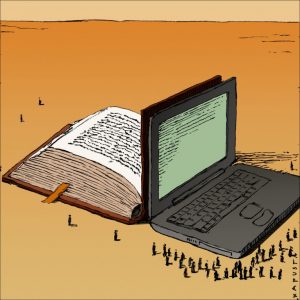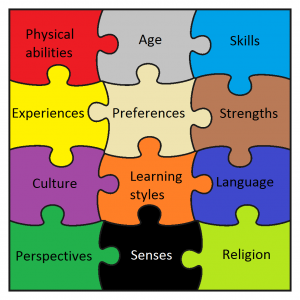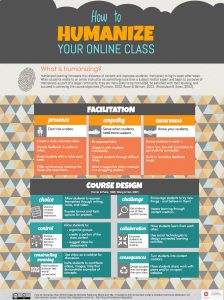In the reading about the Floe Inclusive Learning Design Handbook is a free Open Educational Resource (OER). It designed to assist teachers, content creators, Web developers, and others in creating adaptable and personalizable educational resources that can accommodate a diversity of learning preferences and individual needs. There are many new concepts, ideas, and issues in Floe. Here three points will be listed that are considered essential.
First of all, a fascinating idea is co-creation. Co-creation involves building deeper relationships between students and teachers and between students and other students. Education is considered a joint effort, and learning and teaching have done with students, not students. This perspective is a very novel and new perspective for some people, and it is also very different from the previous thought of education. In the previous learning process, what we did was learn knowledge and skills from teachers and then teach them to future students.
We have overlooked that education is a joint endeavour, something that can be done together between teachers and students. Co-creation is essential because teachers and students are at two different ages. When their various interesting ideas are mixed, the learning process will become more exciting and may have some new inspirations. Teachers do not necessarily know everything, and it is not difficult for students to make interesting points. Co-creation is likely to allow students to collaborate and learn independently through the sense of a learning community and enhance the learning experience of students. When students and professors conduct courseware development and research together, professors can get a lot of inspiration from students’ innovative ideas in order to improve the content of courseware. At the same time, it can also enable students to improve their thinking skills in the process of practice. Co-creation can not only make students more engaged in this course, but also increase their satisfaction with the course. Because students are active participants in the proposal, students can feel the difference between traditional teaching models and innovators in practice.
Secondly, a remarkable idea is translating the handbook into other languages. I sincerely appreciate this. Sometimes even if the content is straightforward but not in a language that students are familiar with, they cannot understand it at all. When I first came to Canada to attend high school, I couldn’t adapt to the environment of English. Mathematics in Canadian high schools was not that hard at the time, and I learned this a long time ago. However, sometimes the misunderstanding of concepts is due to students cannot fully understand the course content or some language comprehension errors. If the handbook can translate into a language familiar to international students, this may be more friendly to students who are new to Canada.
Third, another important idea is Creating alternative presentations of the handbook. For example, it contains some suitable versions of electronic devices or offline reading. Alternative presentations of handbooks are especially crucial in this particular period now. When our physical health cannot be guaranteed, nor can we go to school, we can learn well with a suitable version of mobile devices. Furthermore, some people will prefer the electronic version. The electronic version will not only allow us to organize these learning content better, but it will also be more environmentally friendly. The electronic version has the invaluable advantages of paper handbooks, and it will even become mainstream in the future. When we have an iPad, we can get some of the learning resources we want, and we can adjust the font size and screen brightness according to the comfort of the eyes. The electronic version of the book is cheaper and even free, allowing more children from families who cannot afford the expensive education to get the same quality learning resources as others. At the same time, electronic book resources need only take up a little memory, and can also carry the entire library on a small storage card. The electronic version handbook not only saves paper but also reduces the burden on the planet. It can achieve zero tree felling to achieve the right environmental protection and low carbon. According to the survey, “In the USA in one year, 2 billion books are produced. To get the paper for these books requires consuming 32 million trees.” Even more exaggerated is that around 40 football fields of trees cut down every single minute. Nature will one day punish humanity, and polar bears will one day lose their homes. If the electronic version of the handbook can reduce a little damage to the earth, each of us has a responsibility to choose this way.


Two concepts are difficult to understand in the reading of these two weeks. The first one is to Derive, remix, and reuse the handbook’s content. I also saw other students annotated this and said they want to learn more about this. The second the Creative Commons 2.5 Canada License. I do not understand what this license is and why all content in the handbook licensed under this 2.5 Canada License.
Finally, the last question that came to the mind is concerning the universal design that not addressed in this module. Universal design should meet the needs of potential students with a wide variety of characteristics. Disability is one of these characteristics. For example, one student could be Hispanic, six feet tall, male, thirty years old, an excellent reader, primarily a visual learner, and deaf. When we are designing a course, the universal design requires consideration of all characteristics.

References:
- Retrieved from https://www.scmp.com/lifestyle/family-education/article/1083971/massive-open-online-courses-learning-revolution
- Retrieved from https://www.tiredearth.com/articles/less-paper-save-forests-rescue-environment
- Retrieved from https://udlleurope.wordpress.com/
- Retrieved from https://decoline-shipping.com/qa/how-many-trees-are-cut-down-for-textbooks.html


